






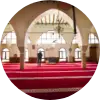





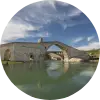
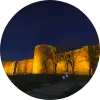
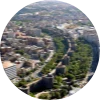
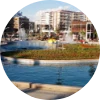
Diyarbakır Grand Mosque, located in the southeastern city of Diyarbakır, Turkey, is one of the most famous and largest mosques in the country. It stands among the oldest mosques in Anatolia and is considered the 5th Harem-i Şerif (Noble Sanctuary) in the Islamic world. The mosque sprawls over a vast area with two mosques and two madrasas. Throughout history, architectural decorations, inscriptions, and reliefs made in different periods harmonize within its courtyard.
Within the mosque's courtyard, there are two mosques separated for Shafi'is and Hanafis, along with Zinciriye Madrasa and Mesudiye Madrasa. The mosque comprises sections such as ablution area, minaret, eastern and western maksuras (enclosures), and a large rectangular courtyard. The main entrance is the eastern gate of the mosque, which features relief figures symbolizing the struggle between a lion and a bull at its corners.
Moreover, the courtyard of the mosque houses an octagonal ablution fountain and a sundial that is over 800 years old. The sundial was used to tell time based on the shadow patterns formed on the ground as the sun moved.
Diyarbakır Grand Mosque was built on the site of the Martoma Church, which was constructed in 639 CE during the era of Caliph Umar (may Allah be pleased with him). It was rebuilt and took its present form under the orders of Sultan Melikshah of the Great Seljuk Empire in 1091. Inside the mosque, there are inscriptions belonging to many Ottoman and Seljuk rulers such as Melikshah, Inal, Nisanoğulları, and Gıyadettin Keyhüsrev.
One of the notable features of Diyarbakır Grand Mosque is the diversity of inscriptions, reliefs, and architectural decorations from different periods. These elements signify the mosque's long history and its adaptation over various eras. Additionally, the mosque's possession of an over 800-year-old sundial adds to its uniqueness.
Situated in the city center, Diyarbakır Grand Mosque is easily accessible via air travel from outside the city. After arriving at the airport, reaching the mosque is convenient. It stands as one of the city's most significant landmarks, visited by numerous travelers and historians throughout history.